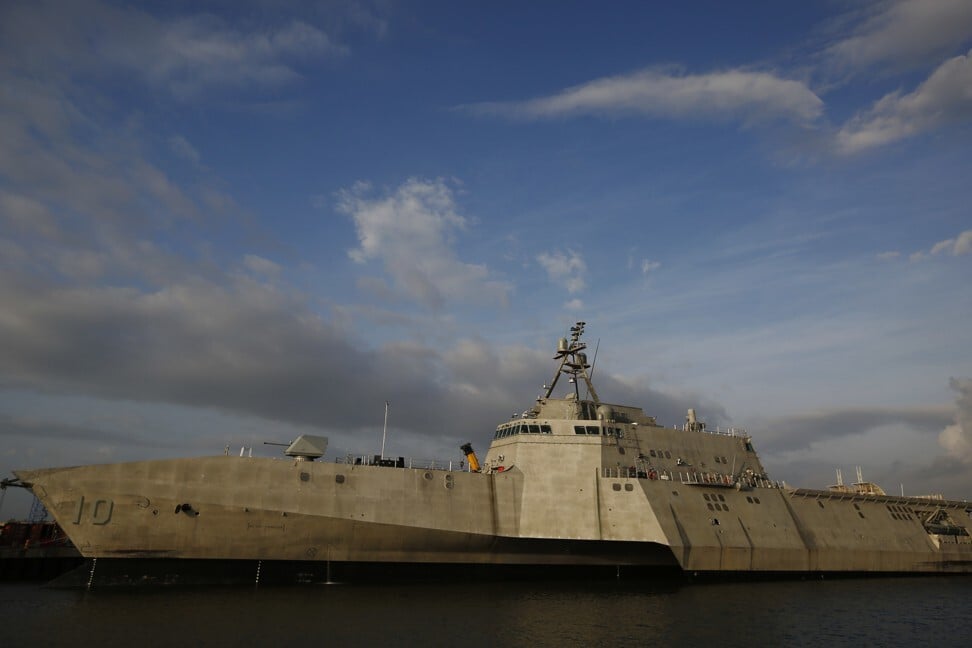These probes more than likely are collecting data for potential military strikes in the event of a war. Not only is the South China Sea of major concern, but so is the Straight Of Malacca that is a chokepoint of global shipping. This is the same location where the USS John S. McCain collided with a tanker in August, 2017. Shipping through the Strait of Malacca doubled in a decade in 2017. If the strait was blockaded ("Malacca Paradox") for any reason, or a war erupted between the US and its regional allies with China, it would shut down global trade. We are moving closer to this ominous scenario. Is President Trump's recent promise to "mobilize the military for vaccination" really about mobilizing the military for military martial law in the United States and war overseas?
US Navy launches live-fire missiles in 'warning to China'
At the same time, China's PLA are stepping up their military exercises as the USS Rafael Peralta probed China close to Shanghai on 15 May 2020. What we see here is escalation on both sides with China kicking off military exercises in response. As it stands right now, the US military will not be leaving the South China Sea and if anything will only increase its military presence. Part of what is being called a "stand off" is about China coveting Taiwan's technology sector (microprocessors) especially TSMC. Taiwan is considered the "tool shed" of the coming "4th industrial revolution" and if that falls into China's hands, China will own the future. China must have this technology to power its economic future.
Taiwan's semiconductor industry is stuck between Trump and Huawei
Two US warships steam to the rescue of a drilling ship being harassed by Chinese Navy in disputed sea after Washington accuses Beijing of 'bullying'
A few scenarios to think about: TSMC is promising to build an $11 billion CPU and GPU fabrication in Arizona to replace the disaster that is Intel - thanks Israel and Russia. Taiwan Semiconductor is 100 miles from China. The 4th industrial revolution "tool shed" in Taiwan is next door to China. Is it possible the US military technology juggernaut will take out Chinese high tech? Will Taiwan Semiconductor Manufacturing Company (TSMC) get "accidentally" hit and put out of action? Lucky break for Intel wouldn't it be?
________
Source: This Week In Asia
Asean stays on the sidelines as South China Sea tensions mount
• Vietnam and the Philippines have lodged protests against China's activities but other Southeast Asian states have been restrained in reacting
• While Washington's presence is welcome, Asean countries will not publicly admit it and neither will they attempt a collective response, says an analystBy Nyshka Chandran | 16 May, 2020
In Southeast Asia, Vietnam, Malaysia, Brunei and the Philippines have claims to the South China Sea. File photo: Reuters
When West Capella, a drill ship hired by Malaysia's national oil company Petronas to survey for oil in the South China Sea completed its activities last week, the US Navy ship Gabrielle Giffords left its base in Singapore to sail past it.
It was the third time in recent weeks that the United States had conducted "presence operations" in the resource-rich waters, which has been the site of renewed tensions between China and its Southeast Asian neighbours over the latter’s oil exploration and fishing activities.
Beijing claims a massive section of the South China Sea that extends roughly 1,000 miles from its southern shores. It has used Chinese government survey vessels, coastguard ships and fishing militia boats to maintain a presence there.
The USS Gabrielle Giffords. File photo: AP
While Beijing has said the vessels are carrying out normal activities, Washington has accused China of "bullying tactics". In 2018, Vietnam – which has territorial claims in the disputed waterway along with Malaysia, Brunei and the Philippines – suspended oil drilling projects by Spanish firm Repsol, reportedly due to Chinese pressure.
Among Asean countries, Hanoi has been most vocal in its opposition to Beijing's claims and activities, followed by Manila.
The remaining eight Asean members have remained largely reticent and when they have commented, remarks have focused on the importance of avoiding conflict and maintaining regional stability.
Analysts believe that individual countries will not publicly quarrel with China for fear of affecting trade and investment ties, especially amid an economic downturn brought on by the coronavirus pandemic.
Joseph Liow Chin Yong, who is an expert on Asia-Pacific geopolitics at Singapore's Nanyang Technological University, said the preference of Asean states was to engage in behind-the-scenes diplomacy, which allowed them to defend their integrity without burning any bridges with Beijing.
Please go to This Week In Asia to read the entire article.
________
Intelligence briefing for 15 May 2020:
Intelligence briefing for 26 April 2020:
Related:
Trump Says He May Cut Ties With China, Not Interested in Speaking With Xi


No comments:
Post a Comment
Note: Only a member of this blog may post a comment.